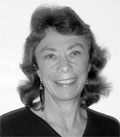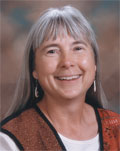
| Life 101 | |
| by Jean Schilt-Silk ’72 and Nancy Taylor-Oswald ’72 |
First place alumni essay
 The black-and-white photo of the Many Farms Indian Reservation School gives the impression of a space station on a barren and desolate planet. The buildings look like those of a correctional institution, the land around them inhospitable. The fact that the photo is in black and white means little. If it had been in color, only the tones would have changed from grays to the colors of pale shale and ecru stretching for miles into the Arizona desert.
The black-and-white photo of the Many Farms Indian Reservation School gives the impression of a space station on a barren and desolate planet. The buildings look like those of a correctional institution, the land around them inhospitable. The fact that the photo is in black and white means little. If it had been in color, only the tones would have changed from grays to the colors of pale shale and ecru stretching for miles into the Arizona desert.
This was our Child Psychology class. Not the one that everyone else was taking back on campus at CC, but the one that the Block Plan and Professor Doug Freed made possible. Our first reading assignment for the class had been about the effects of culture on child rearing. We read that Indian babies, wrapped snuggly in their papooses, cry less than unwrapped babies. The next day Jean said, “I don’t want to sit in the classroom and read about this. I want to see it for myself.” Dr. Freed agreed, found funding, and two days later we were headed for the Navajo Indian Reservation for what ended up to be a lesson in Life 101.
 It was awkward when we arrived at the school — no one was expecting us. But we were soon settled into the only space with two free beds, the infirmary. The next day we spoke with school personnel who assigned Nancy as a substitute teacher and Jean as a generic volunteer.
It was awkward when we arrived at the school — no one was expecting us. But we were soon settled into the only space with two free beds, the infirmary. The next day we spoke with school personnel who assigned Nancy as a substitute teacher and Jean as a generic volunteer.
The memories of our experience are varied. The food in the school cafeteria was bad, the coffee awful. We supervised bingo games and watched Western movies with the Navajo children, who cheered for the cowboys and booed the Indians. We learned that the campus lights had been shot out so that students could escape the watchful eyes of administrators, and about a boy who had been drinking and was found frozen to death.
A Native woman asked us why we were there. When we told her, she spoke sharply about resenting white people who came to study them like animals in a zoo. The school counselor talked about the loneliness of the little children, separated from their families on the reservation, forced to board at the school. Jean asked her how the children got love. “Oh, honey,” she answered, “there’s no love.”
On the trip home, we reflected on our experience and how we would present it to Professor Freed to justify our grades. Reflecting on it now, more than 30 years later, it is clear that it has had a life-long impact. Nancy lived for 12 years in British Columbia, where she taught in all-Native schools; Jean has worked extensively in cross-cultural, experiential, and international education. She continues to find her most meaningful experiences as a learner and educator outside the classroom.
Since our years at CC, our lives and perspectives have broadened, but the seeds for that growth were planted by the Block Plan. No love, honey? We continue to search.
Here's one of 35 facts about CC:
4
The college has a student-to-faculty ratio of 10 to 1.
The Colorado College | 14 East Cache La Poudre Street | Colo Sprgs, CO | 80903 | 719-389-6000